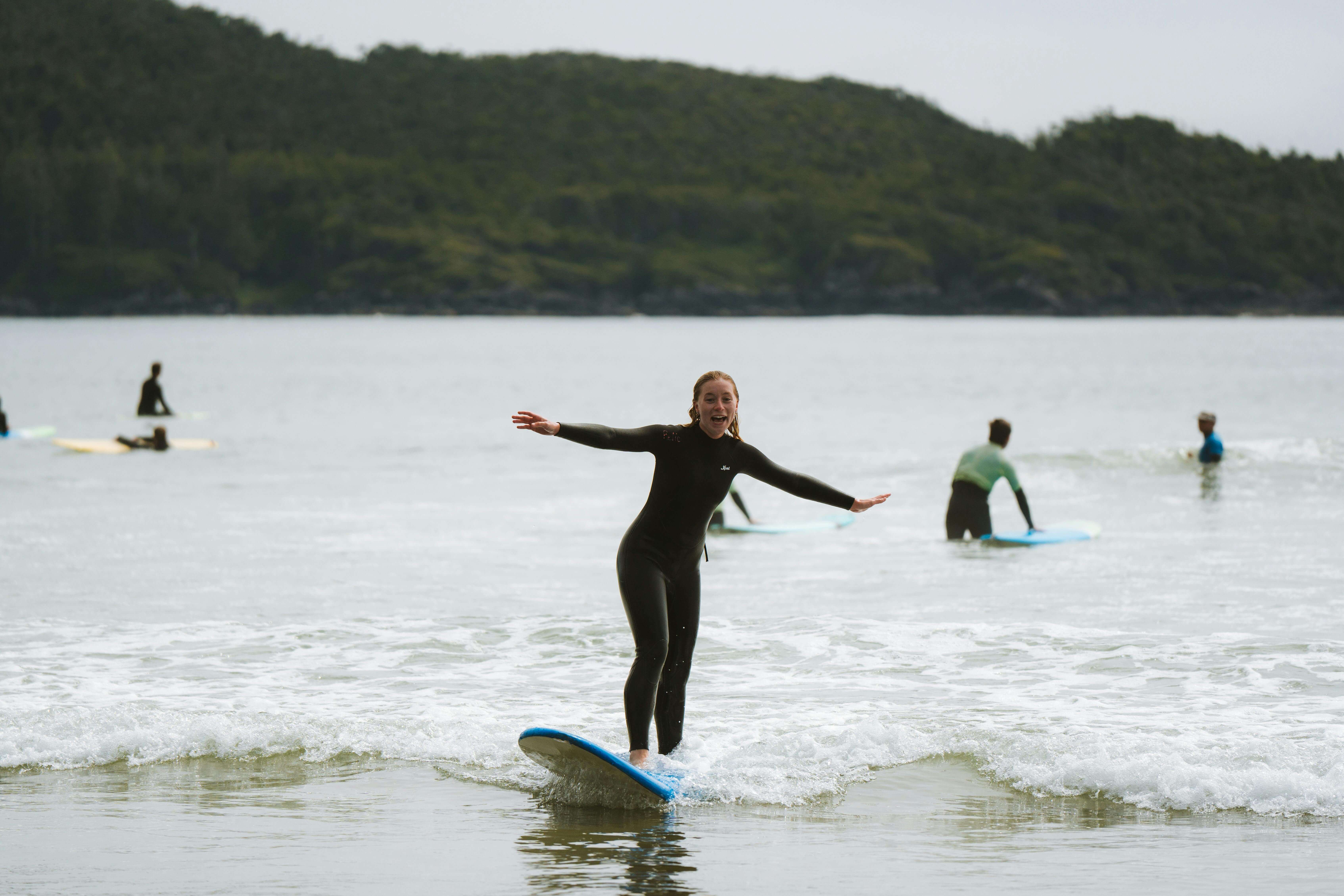
The moment when a surfer transitions from lying prone on their board to standing upright is perhaps the most critical movement in all of surfing. This explosive, fluid motion—known as the pop-up—separates confident wave riders from struggling beginners and determines whether you'll successfully catch a wave or watch it pass beneath you. Mastering the surfboard pop up technique is essential for every surfer, regardless of skill level, as it forms the foundation for everything that follows on a wave.
The pop-up might look effortless when performed by experienced surfers, but it's actually a complex sequence of coordinated movements that requires proper technique, timing, and practice. A well-executed pop-up happens in under two seconds, seamlessly transitioning from paddling position to riding stance without disrupting the board's momentum or stability. Understanding the mechanics, common mistakes, and progressive training methods will help you develop this crucial skill more effectively.
Understanding the Mechanics of the Pop-Up
The surfboard pop up technique begins before you even attempt to stand. Your body position while paddling sets the stage for a successful transition. You should be lying centered on your board with your chest up, looking forward at the wave you're paddling for. Your hands should be positioned flat on the board, roughly at chest level, ready to push when the moment arrives.
The actual pop-up consists of several interconnected phases that must flow together smoothly. First comes the push phase, where you press down firmly with your hands to lift your upper body off the board. This isn't just about arm strength—your core muscles must engage to maintain stability and control throughout the movement.
Next is the knee-draw phase, where your back leg comes forward while your front leg prepares to find its position. This is often where beginners struggle most, as the tendency is to bring both knees up simultaneously or to hesitate mid-movement. The key is to commit fully to the motion while maintaining your center of gravity over the board.
The final phase involves placing your feet in the correct surfing stance and finding your balance. Your front foot should land roughly where your chest was positioned, while your back foot goes near the tail of the board. Your knees should be slightly bent, with your weight evenly distributed and your arms extended for balance.
The Step-by-Step Breakdown
Beginning with proper paddle position, ensure your body is positioned correctly on the board with your chest lifted and eyes looking forward. Your hands should be flat against the board at chest level, fingers spread for maximum purchase. When you feel the wave's energy lifting your board and you're committed to the ride, it's time to initiate the pop-up sequence.
Start by pressing down firmly with your hands, similar to performing a push-up. Your arms should be strong and confident, lifting your chest and shoulders well off the board. This creates the space needed for your legs to move into position. Keep your head up and eyes forward throughout this movement—looking down at the board will throw off your balance and timing.
As your upper body rises, begin drawing your back leg forward. This leg will become your front leg in your surfing stance. The movement should be smooth and controlled, bringing your knee toward your chest while keeping your front leg extended. Think of it as stepping through rather than jumping up.
Place your front foot where your chest was positioned, approximately in the center of the board. Your foot should be angled slightly toward the nose of the board, not perfectly perpendicular to the stringer. Simultaneously, your back foot should find its position near the tail, giving you a stable, athletic stance.
The entire sequence should flow as one continuous movement. Any pause or hesitation between phases will disrupt your momentum and make the pop-up more difficult. Practice the motion slowly at first, focusing on smooth transitions between each phase rather than speed.
Common Mistakes and How to Avoid Them
One of the most frequent errors in executing the surfboard pop up technique is the "step-up" method, where surfers place one foot at a time instead of moving both feet simultaneously. This approach is slower, less stable, and often results in the surfer being thrown off balance by the moving wave. Instead, focus on the coordinated movement of both legs working together.
Another common mistake is looking down at the board during the pop-up. Your eyes should remain focused on where you want to go, not on your feet or the board surface. Looking down shifts your center of gravity forward and makes it much harder to maintain balance once you're standing.
Many beginners also struggle with hand placement, either positioning their hands too far forward or too far back on the board. Hands should be placed flat against the board at chest level, providing the leverage needed for a strong push while maintaining proper weight distribution.
Rushing the movement is another frequent issue. While the pop-up should be quick, it shouldn't be frantic. A controlled, fluid motion is more effective than a panicked scramble. Focus on smooth execution rather than pure speed, and the quickness will develop naturally with practice.
Finally, many surfers fail to commit fully to the movement. Half-hearted attempts or hesitation mid-pop-up almost always result in failure. Once you begin the sequence, follow through completely with confidence and determination.
Building Strength and Flexibility
The pop-up demands specific physical attributes that can be developed through targeted training. Upper body strength is crucial for the initial push phase, but don't neglect your core muscles, which provide stability throughout the movement. Push-ups, planks, and burpees are excellent exercises for building the strength needed for consistent pop-ups.
Flexibility is equally important, particularly in your hips and shoulders. Tight hip flexors can make it difficult to bring your legs through smoothly, while limited shoulder mobility can affect your push-off power. Regular stretching, yoga, or dynamic warm-up routines will improve your range of motion and make the pop-up feel more natural.
Hip mobility deserves special attention since the leg movement required for the pop-up involves significant hip flexion and rotation. Exercises like leg swings, hip circles, and deep lunges will help develop the flexibility needed for smooth foot placement.
Practice Methods and Progression
The beauty of the surfboard pop up technique is that it can be practiced almost anywhere, not just in the water. Start by practicing on land using a surfboard, yoga mat, or even just the floor. Focus on the movement pattern first, gradually increasing speed as your muscle memory develops.
Begin with slow, deliberate movements, holding each position briefly to ensure proper form. Pay attention to hand placement, foot positioning, and overall body alignment. As you become more comfortable with the sequence, work on making the transitions smoother and more fluid.
Once you can perform consistent pop-ups on land, take your practice to the water in small, gentle waves. White water or reformed waves are perfect for this stage, as they provide forward momentum without the complexity of steep wave faces or critical timing.
Progressive training involves gradually increasing the difficulty of conditions as your technique improves. Start in waist-deep water with rolling waves, then progress to chest-deep water with more organized surf. Each environment will present new challenges and help refine your pop-up under different conditions.
Mental Aspects and Timing
The psychological component of the pop-up is often underestimated. Confidence plays a huge role in successful execution—doubt or hesitation will sabotage even the most technically sound attempt. Visualization techniques can help build confidence by mentally rehearsing the movement sequence until it becomes automatic.
Timing is another crucial mental skill. Learning to read waves and understand when to initiate your pop-up comes with experience, but you can accelerate this learning by studying other surfers and paying attention to wave behavior. The pop-up should begin when you feel the wave's energy lifting your board and providing forward momentum.
Developing a pre-pop-up routine can also help with consistency. This might include taking a deep breath, checking your hand position, and giving yourself a mental cue. Having this routine builds confidence and ensures you're physically and mentally prepared for the movement.
The journey to mastering the perfect pop-up is ongoing, even for experienced surfers. Environmental factors, board characteristics, and wave conditions all influence the technique, requiring constant adaptation and refinement. However, with dedicated practice and attention to proper form, the pop-up will become second nature, allowing you to focus on the pure joy of riding waves rather than the mechanics of getting to your feet.




